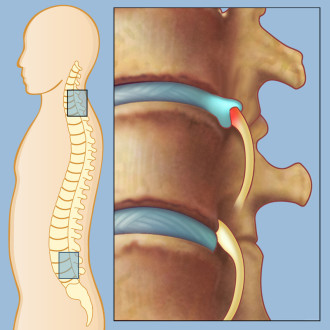Read about Lumbar Radiculopathy Symptoms and Treatment. Lumbar Radiculopathy exercise and spondylosis. Cervical radiculopathy.
Radiculopathy is a pinched nerve in the spine. It occurs when surrounding bones, cartilage, muscle, or tendons deteriorate or are injured. The trauma causes these tissues to change position so that they exert extra pressure on the nerve roots in the spinal cord. Nerves control sensations and movement in the body.
Lumbar radiculopathy is a painful condition that happen when a nerve in lumbar spine (lower back) is pinched or irritated producing pain, tingling, numbness, and/or weakness going into the leg. Lumbar radiculopathy is a disorder of the spinal nerve root from L1 to S1. It can cause sciatica, or shooting pain in the legs. Incontinence, sexual dysfunction, or severe paralysis can also occur in severe cases.

Lumbar Radiculopathy Symptoms and Treatment
Lumbar Radiculopathy Causes
Lumbar radiculopathy is caused by compression or irritation of the nerves as they exit the spine. This can be due to mechanical compression of the nerve by a disc herniation, a bone spur (osteophytes) from osteoarthritis, or from thickening of surrounding ligaments. As people age, their spines are subject to increasing degeneration (increased tearing of the disc) which can cause herniated discs and similar problems leading to lumbar radiculopathy.
Other less common causes of mechanical compression of the nerves is from a tumor or infection. Either of these can reduce the amount of space in the spinal canal and compress the exiting nerve. Scoliosis can cause the nerves on one side of the spine to become compressed by the abnormal curve of the spine.
Risk for a pinched nerve and lumbar radiculopathy increases due to following factors:
- Smoking
- Diabetes
- Spinal infection
- Growth in spine (osteophytes)
- Arthritis
- Overweight or obese
- Being male
- Old age
- Family history
- Pregnancy
Symptoms of Lumbar Radiculopathy
The clinical presentation of lumbar radiculopathy will vary depending on the cause of the radiculopathy and which nerve roots are being affected. Patients will often present with pain in the lumbar region that radiates through one or both legs.
This pain is often described as burning, stabbing, or shooting. For this pain to be considered radiculopathy, however, neurological signs must be present such as weakness, numbness, or reflexive changes.
General symptoms of a Lumbar radiculopathy are:
- Failure of the dermatome due to the overlap of the dermatomes there will never be a total loss of touch by an injury of one nerve root
- Radiating pain, coupled with irritation in the periphery
- Tendon reflexes are reduced or fall out
- Sometimes motor loss
Treatment of Lumbar Radiculopathy
Medical management includes patient education, medications to relieve pain and muscles spasm, cortisone injection around the spinal cord (epidural injection), physical therapy, anti-inflammatory medications, or chiropractic treatment, and avoiding activity that strains the neck or back.
By research the majority of radiculopathy patients respond well to this conservative treatmentand symptoms often improve within six weeks to three months. If nerve root compression is persistent discectomy will be considered
Conservative Management
It consists of following:
- Physical therapy: Physical therapy treatment plan include mild stretching and pain relief modalities, such as ultrasound, massage, ice and heat pack therapy, electrical stimulations like TENS, active stabilization, laser therapy, conditioning exercise and ergonomic program.
- Rest:Activities that aggravate the pain should usually be limited. Physicians can prescribe a splint, brace, or soft collar to immobilize the affected area. This helps to facilitate rest. In extreme cases, bed rest or traction may be necessary.
- Medications: medications such as non-steroidal anti-inflammatory drugs (NSAIDs) to reduce swelling and analgesics to relieve pain.
- Injections:Epidural steroid injections and nerve root injections to help reduce swelling and treat acute pain that radiates to the hips or down the leg.
Surgical Management
Most sources agree on the urgent and definitive indications for surgical intervention in patients with lumbosacral radiculopathy eg, significant/severe and progressive motor deficits, cauda equina syndrome with bowel and bladder dysfunction. The surgical treatment options are as follows:
- Simple discectomy
- Discectomy plus fusion
- Chemonucleolysis
- Percutaneous discectomy
- Microdiscectomy
It is advised to undergo surgery to relieve pinched nerve or lumbar radiculopathy if condition has not improved with conservative management.
Prevention
While some causes of radiculopathy are not avoidable, there are some ways to reduce the risk. To prevent complications
- Maintain a good posture
- Healthy weight
- Use safe techniques when lifting heavy objects
- Take frequent breaks while doing repetitive tasks
- Stayphysically active by developing a regular exercise program that
- incorporates strength and flexibility exercises
 Health & Care Information
Health & Care Information 

